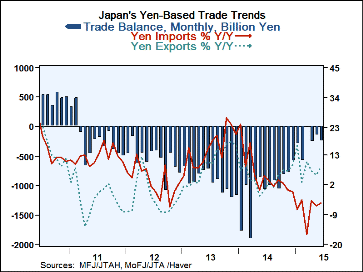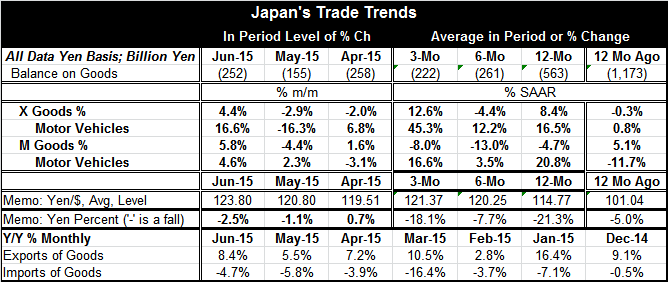 Global| Jul 23 2015
Global| Jul 23 2015Japan's Trade Shows Little Change
Summary
Japan's trade trends show little alteration over the last few months. Over that period, exports have grown year-over-year in a range from 5.5% to 8.4% while imports have declined by 3.9% to 5.8%. The trade gap has fluctuated between [...]
 Japan's trade trends show little alteration over the last few months. Over that period, exports have grown year-over-year in a range from 5.5% to 8.4% while imports have declined by 3.9% to 5.8%. The trade gap has fluctuated between -155 billion yen and -258 billion yen. And there has been no sense of trend. But the chart shows that these data over the last four months are a world part from earlier trends which found deficits on the order of 500 billion yen to one trillion yen. Since mid-2014, the big driver of trade improvement has been reduced imports. Year-over-year trends in export growth have been volatile but have not seen any change since late-2014.
Japan's trade trends show little alteration over the last few months. Over that period, exports have grown year-over-year in a range from 5.5% to 8.4% while imports have declined by 3.9% to 5.8%. The trade gap has fluctuated between -155 billion yen and -258 billion yen. And there has been no sense of trend. But the chart shows that these data over the last four months are a world part from earlier trends which found deficits on the order of 500 billion yen to one trillion yen. Since mid-2014, the big driver of trade improvement has been reduced imports. Year-over-year trends in export growth have been volatile but have not seen any change since late-2014.
Sequential growth, patterns from 12-month to 6-month to 3-month, show an erratic export trend with a hint of improvement. Imports are without clear trend on this horizon but show a tendency to weaken. Both auto exports and auto imports remain strong, but auto exports are accelerating; imports demonstrate a tendency toward weaker growth.
The yen has generally been falling over the past year, having dropped by 21% vs the dollar. The weaker yen has helped to cheapen exports and make imports more expensive. We see that in the tendencies for growth in exports and imports under one year.
Despite the recent trade improvement on the back of the weakening yen, Japan will have a hard time trying to grow its way out of its situation using trade as a crutch. World demand is still weak. Japan, like Europe, is running a weak exchange rate policy; however, in both euro and in Japan, the weaker currency has been slow to pay dividends.
Japan's two main trading partners are the United States and China. While the U.S. has been growing, its growth has been slow and with uneven consumption - except for motor vehicles where sales have been brisk. China has been embroiled in a slowdown phase (albeit with still globally impressive growth rates), a phase from which it may be emerging. But the recent turmoil in China's stock market may pose a new challenge for China's growth. The authorities' decision to employ an artificial fix has harmed confidence in China's economy and has caused inventors to look back at the previous good stock market performance with more skepticism. Unless Japan's two largest trade partners pick up their growth, Japan itself will continue to struggle. Its load of domestic debt is prodigious. Its attempts to gain control of government debt with value-added tax increases have proved troublesome as tax hikes have sunk economic growth each and every time they have been used. Japan is a country without many options for growth. Trade could allow it to tap external sources of demand, but that channel is being sought by too many nations in this low-growth environment.

Robert Brusca
AuthorMore in Author Profile »Robert A. Brusca is Chief Economist of Fact and Opinion Economics, a consulting firm he founded in Manhattan. He has been an economist on Wall Street for over 25 years. He has visited central banking and large institutional clients in over 30 countries in his career as an economist. Mr. Brusca was a Divisional Research Chief at the Federal Reserve Bank of NY (Chief of the International Financial markets Division), a Fed Watcher at Irving Trust and Chief Economist at Nikko Securities International. He is widely quoted and appears in various media. Mr. Brusca holds an MA and Ph.D. in economics from Michigan State University and a BA in Economics from the University of Michigan. His research pursues his strong interests in non aligned policy economics as well as international economics. FAO Economics’ research targets investors to assist them in making better investment decisions in stocks, bonds and in a variety of international assets. The company does not manage money and has no conflicts in giving economic advice.






